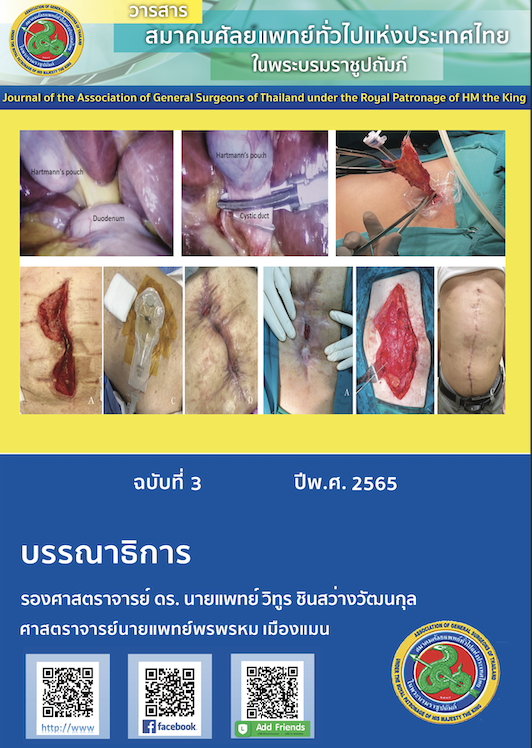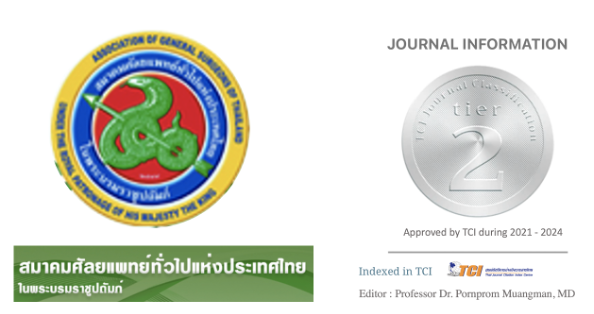แนวทางการรักษา Entero-Atmospheric Fistula
คำสำคัญ:
แผลชอนทะลุลำไส้กับบรรยากาศ, แผลชอนทะลุลำไส้กับผนังหน้าท้อง, การผ่าตัดเปิดผนังหน้าท้อง, การผ่าตัดควบคุมการบาดเจ็บ, ผนังหน้าท้องบทคัดย่อ
Entero-atmospheric fistula (EAF) คือทางเชื่อมต่อที่ผิดปกติระหว่างทางเดินอาหารและบรรยากาศโดยที่ไม่มีผิวหนังหรือเนื้อเยื่อข้างเคียงขวางกั้น ส่วนใหญ่เกิดตามหลังการผ่าตัดควบคุมการบาดเจ็บ (damage control surgery; DCS) ที่มีการเปิดผนังหน้าท้อง (open abdomen) อุบัติการณ์ร้อยละ 5-25 ของผู้ป่วยที่ได้ทำ DCS มีอัตราการเสียชีวิตร้อยละ 20-60 การรักษาควรทำตามลำดับขั้นตอนโดยเริ่มจากการรักษาให้ร่างกายผู้ป่วยมีเสถียรภาพด้วยการแก้ไขความผิดปกติของสารน้ำและเกลือแร่ การควบคุมการติดเชื้อ การให้ยาเพื่อควบคุมสารคัดหลั่ง การให้โภชนบำบัดด้วยวิธีการที่เหมาะสม และการดูแลแผลรูเปิด ขั้นตอนถัดไปคือการตรวจเพิ่มเติมด้วยภาพรังสีที่เหมาะสม เพื่อประเมินกายวิภาคและพยาธิสภาพที่เกี่ยวข้อง ก่อนการตัดสินใจเลือกการรักษาว่าจะเป็นการรอให้ EAF ปิดเองภายใน 4-6 สัปดาห์ หรือการรักษาด้วยการผ่าตัดซ่อมแซม แนะนำให้ทำหลังการวินิจฉัยและฟื้นฟูผู้ป่วยอย่างน้อย 6-12 เดือน ประกอบด้วยการเปิดช่องท้องเพื่อสำรวจ จัดการกับการปนเปื้อนหรือติดเชื้อที่คงค้าง ตัดลำไส้ที่มีรูเปิด ต่อลำไส้ และปิดผนังหน้าท้องด้วยเทคนิคที่ปราศจากแรงตึง ขั้นตอนสุดท้ายคือฟื้นฟูสมรรถภาพของผู้ป่วยจนกว่าจะมีภาวะโภชนาการปกติและสามารถกลับไปใช้ชีวิตได้ตามปกติ




